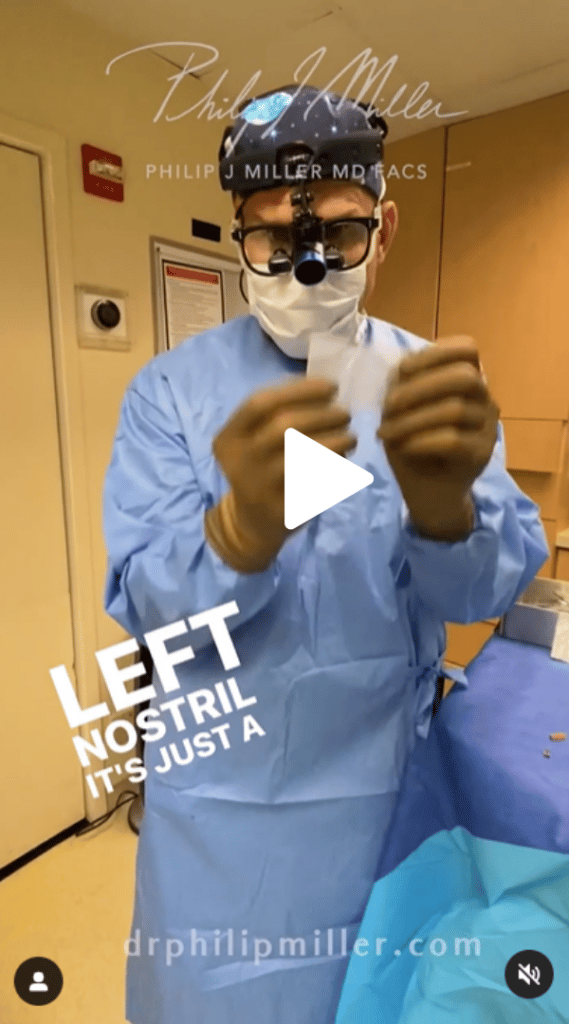8 Common Signs of a Bad Rhinoplasty
As the central feature on the face, the nose has a profound impact on your appearance overall. Rhinoplasty is a plastic surgery procedure that can reshape and resize the nose to create facial harmony. When performed by a highly trained, board-certified plastic surgeon, rhinoplasty can provide seamless alterations and coveted results. However, it is also a delicate process that can go less than perfect at times, sometimes requiring a revision surgery to produce a better result.
Signs of a bad nose job
A bad nose job can lead to cosmetic and functional problems, and the need for revision rhinoplasty. Wondering if you’ve experienced a bad rhinoplasty? Here are the most common signs of a bad nose job:
1. Bridge is Too Low (Scooped Profile)
A low bridge can occur when a surgeon uses a chisel or osteotome. This tool requires precision and can effectively remove a portion of the bridge in one movement. Sometimes that movement is in the wrong place, or the tool can remove too much tissue or cartilage, creating a bridge that is too low. From the side, it can look like a scooped profile. In some cases, the chisel can cause severe damage and weaken the nasal structure, leading to a collapsed nose.
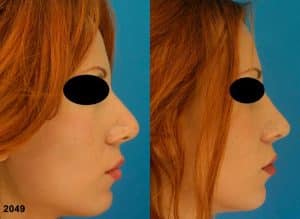
2. Nose Looks Pinched (also pinched nostrils)
After a rhinoplasty procedure, the nose or nostrils can look pinched, making the nose look long and slender. Not only can this bad nose job look unsightly, but it can also result in difficulty breathing due to a narrow passageway that does not allow enough airflow. This common sign of a botched rhinoplasty can result from removing too much internal nostril tissue, resulting in slits for nostrils rather than round holes. It is important to correct this mistake for adequate breathing.
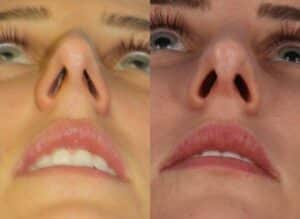
3. Nose Turns Up Too Much
When a rhinoplasty aims to shorten the nose, it can lead to many common side effects that rotate the tip upward too much or leave the tip at an irregular angle. Large amounts of removed tissue from the septum is a poor attempt to raise the nose and a sign of a bad nose job. A nose that is turned up too much can look like a pig snout. This effect is also common due to swelling after surgery but swelling-related issues should dissipate in several weeks. If the nose tip does not drop during the recovery process, revision surgery may be necessary.
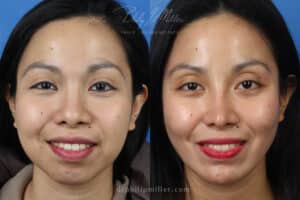
4. Nose Has Pollybeak Deformity
Pollybeak deformity is when the area above the tip is too full and makes the nose protrude downward, looking like a bird beak. This can occur from unpredictable healing but is most often due to a bad nose job. Sometimes not enough cartilage is removed, and the excess tissue in the supratip area can force the nose shape downward. In addition to the cosmetic concern, this mistake can also result in difficulty breathing from one or both nostrils. Pollybeak deformity can also occur due to aggressive removal of a dorsal hump without considering reshaping the area and remaining tissue.
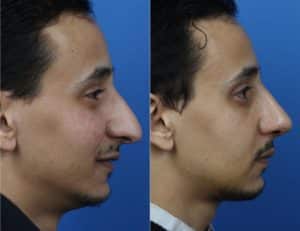
5. Nasal Tip is Same Width as Bridge
In a typical nose shape, the tip should be slightly wider than the bridge for an appealing and cohesive form. A bad rhinoplasty procedure overlooks this knowledge when reshaping and sizing problem areas. When the nasal tip and bridge are the same width, the nose can look unnatural.
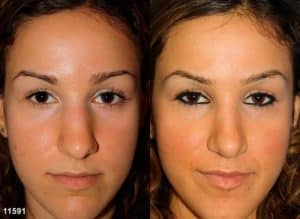
6. Nostrils are Too Wide or Asymmetrical
As a prominent feature, any mistake on the nose is highly noticeable. Disproportionate or asymmetrical nostrils are a common sign of a bad nose job and can be easily prevented with exceptional skill and a strong sense of aesthetics.
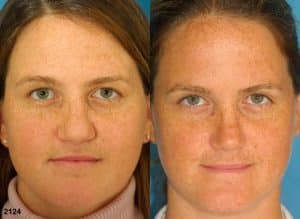
7. Nose is Not Proportionate to Other Facial Features
The main goal of rhinoplasty is to create facial balance and an aesthetically pleasing nose shape and size that flows seamlessly with other features. When a nose job is poorly executed, it can look like your nose does not belong with your other features. Rhinoplasty must be a personalized procedure to ensure proper proportion and flow.
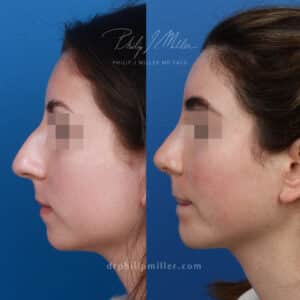
8. You Notice Breathing Difficulty
A cosmetic nose job should not impact the function of the nose. Difficulty breathing is a sure sign of a bad nose job. This error is more common with reductive procedures as too much tissue or cartilage is removed, reducing the internal and external passageway for poor airflow.
Revision rhinoplasty surgeon in New York
If you had a bad rhinoplasty procedure, you may be a candidate for revision rhinoplasty. Revision procedures are often more complex than the initial nose job, so it is critical to choose an experienced, skilled surgeon to perform your procedure and ensure a better outcome.
About Dr. Miller in NYC
Philip J. Miller, MD, FACS, is a double-board certified facial plastic surgeon specializing in cosmetic facial procedures that help patients achieve their aesthetic goals. Dr. Miller is a leading expert in rhinoplasty and facial rejuvenation, focusing on comprehensive treatment plans for natural results. He uses the NatraLook® process, which empowers patients to explore their aesthetic beauty and provides a supportive space to discuss a unified vision.
Contact us to schedule a consultation at our New York or New Orleans office and learn more about rhinoplasty and revision rhinoplasty.
Do I need rhinoplasty or septoplasty?
Noses can have a range of issues that patients want corrected. Septoplasty and rhinoplasty are two common surgical procedures used to correct various nasal abnormalities. Despite being similar in name, the two procedures are actually quite different. A septoplasty focuses on the internal structure of the septum to correct functionality, while a rhinoplasty focuses more on the outer appearance and aesthetics of the nose.
While both procedures are centered around the nose, each method has a designated goal and outcome that can provide patients with a better-looking and functioning nose. Do you need rhinoplasty or septoplasty? Take a look:
Rhinoplasty vs septoplasty: what’s the difference?
Septoplasty is a common procedure to correct breathing problems, and rhinoplasty is used to correct aesthetic features like nose shape and size. Septoplasty is used to correct septal deviations. The septum is the cartilage that separates the nasal passages. When this cartilage shifts to the side, known as a deviated septum, it can affect your ability to breathe easily and lead to nasal blockages and frequent nosebleeds. Septoplasty realigns the septum to achieve symmetry in the nasal cavities and improve nasal function.
A rhinoplasty, also known as a nose job or nose reshaping surgery, is used to improve the appearance of the nose. Many patients feel the shape or size of the nose detracts from other facial features, and a nose job can make minor changes or reconstruct an entire nose to make it fit harmoniously with other facial features. It is a highly complex procedure that can be personalized to fit each patient’s desires and aesthetic beauty goals.
While they have their differences, septoplasty and rhinoplasty are both surgical procedures that require the care and expertise of a board-certified facial plastic surgeon. It is critical to work with a surgeon that has years of experience to ensure your results are seamless and natural.
When to choose rhinoplasty?
Although rhinoplasty is a popular cosmetic procedure, it is not for everyone. You may be a candidate for rhinoplasty if you:
- Are in good overall health
- Want to improve facial balance
- Have an irregularity like a bulbous tip
- Want to address ethnic nose characteristics
A rhinoplasty can address many irregularities, including:
- Size of the nose
- Shape of the nasal tip
- Wide or narrow nostrils
- Angle of the nose
- Nose and upper lip that are too close together
- Hooked or crooked nose
- Hump or bump
- Nose asymmetry
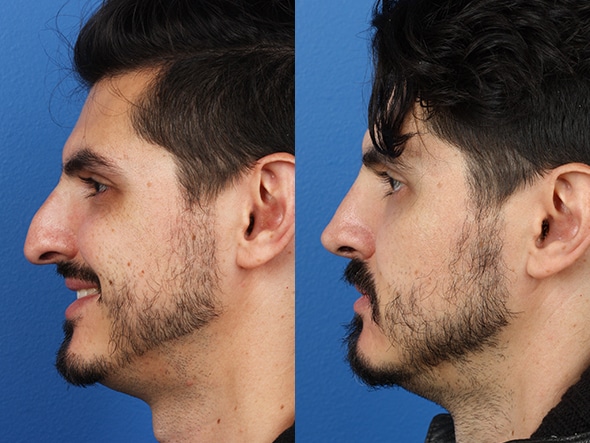
When to choose septoplasty?
You may be a candidate for septoplasty if you experience:
- Excessive snoring
- Sleep apnea
- Recurrent sinusitis
- Breathing difficulties
- Respiratory complaints
- Deviated septum due to injury or trauma
Septoplasty has many benefits associated with clearing the nasal passage, including:
- Uninterrupted breathing patterns
- Better sleep
- Improved airflow
- Self-maintained airways and drainage passageways
- Reduced sinus infections
- Improved smell and taste
Can I get rhinoplasty with septoplasty at the same time?
Yes, rhinoplasty with septoplasty is a common surgical combination. Having rhinoplasty and septoplasty at the same time is a popular choice for patients in need of improved functionality and appearance. It allows you to receive the best of both worlds – the improved breathing offered by septoplasty while adjusting cosmetic irregularities like a hump or bulbous tip. It is safe and effective to correct all issues with one procedure to reduce recovery time and ensure all changes are cohesive.
Your expert facial plastic surgeon should comprehensively evaluate your needs to determine if you need septoplasty and rhinoplasty procedures to achieve your desired results and eliminate any functional issues you might have. There are several benefits to having the procedures done together, such as:
- One surgical cost
- One recovery time
- Convenience
- Possible insurance coverage for the septoplasty portion of the procedure
- Better outcomes aesthetically and functionally
Septoplasty and rhinoplasty surgeon in New York
Philip J. Miller, MD, FACS, is a world-renowned plastic surgeon who is double board-certified in facial plastic and reconstructive surgery of the head and neck. He has more than 20 years of experience with facial plastic surgery and is considered a leading expert in rhinoplasty and facial rejuvenation. He is a highly acclaimed surgeon offering custom treatment plans to help patients meet their aesthetic goals.
Dr. Miller uses the NatraLook® process, an enriching experience that allows patients to explore their confidence in a safe and supportive environment. He creates a unified vision with patients by discussing their personal desires and obstacles. Contact us to schedule a consultation and learn more about septoplasty and rhinoplasty.
When to Choose a Nose Tip Surgery Over Full Rhinoplasty?
Sometimes the aesthetic improvements you’re looking for can be achieved with nose tip surgery rather than a full rhinoplasty. If your concerns are centered around the appearance of the tip, nasal tip refinement may be sufficient for you. If you’re looking for a more dramatic result that involves other parts of the nose, a full rhinoplasty may be a better choice.
A nose tip job can effectively address a number of issues to elevate your aesthetic appeal and improve your self-esteem. Before your consultation, check out these common aesthetic concerns to help you determine whether rhinoplasty tip refinement is the right choice for you.
Droopy Tip
A droopy tip can appear just when you smile or it may be apparent all the time. It can be a genetic trait or the result of a previous rhinoplasty. This cosmetic concern can be altered with a nasal tip rotation surgery that focuses exclusively on lifting and refining the nose tip.
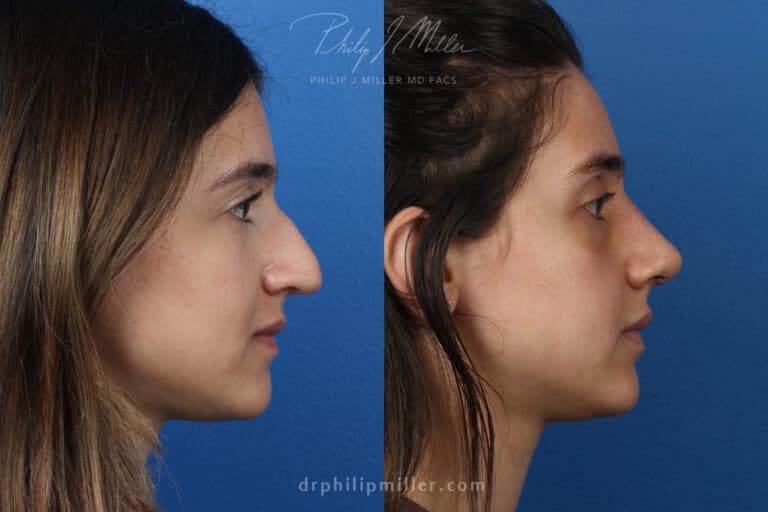
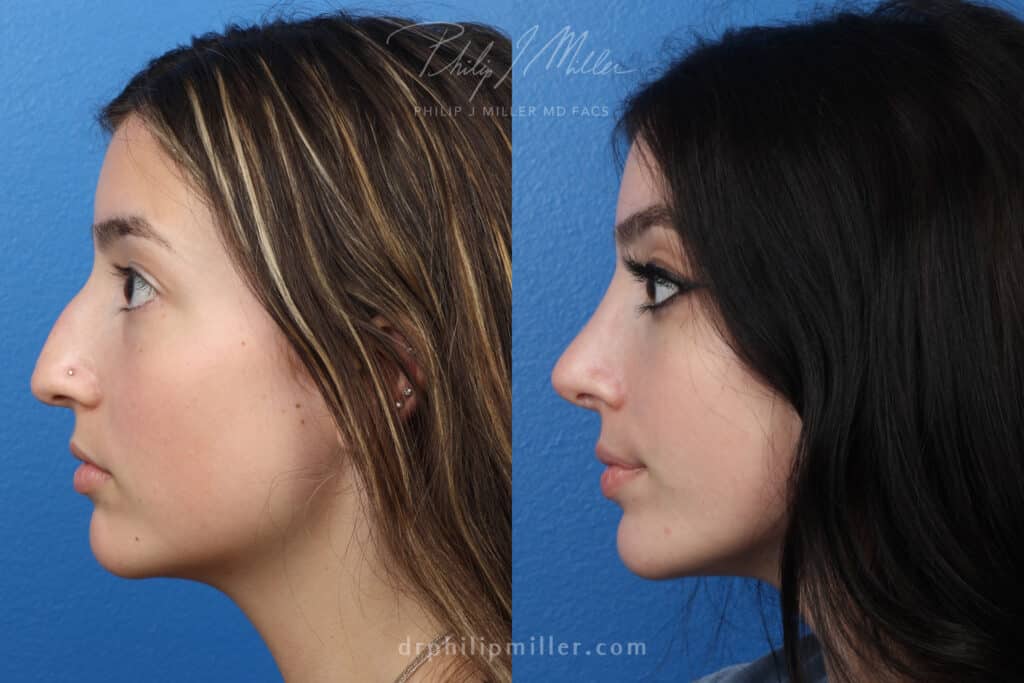
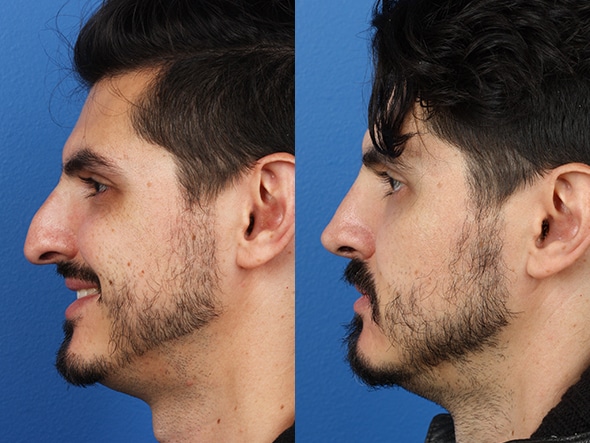
This procedure internally points the tip of the nose upwards, increasing the angle between the upper lip and the bottom edge of the nose. This gets rid of the “droopy” appearance.
There are a variety of ways that Dr. Miller can effectively address a droopy tip. These can include trimming excess cartilage, shortening the nasal septum, or reducing the length of the lateral cartilage. Sutures can be used on lower lateral cartilage to lift the tip, or a graft could be used to increase nasal tip support.
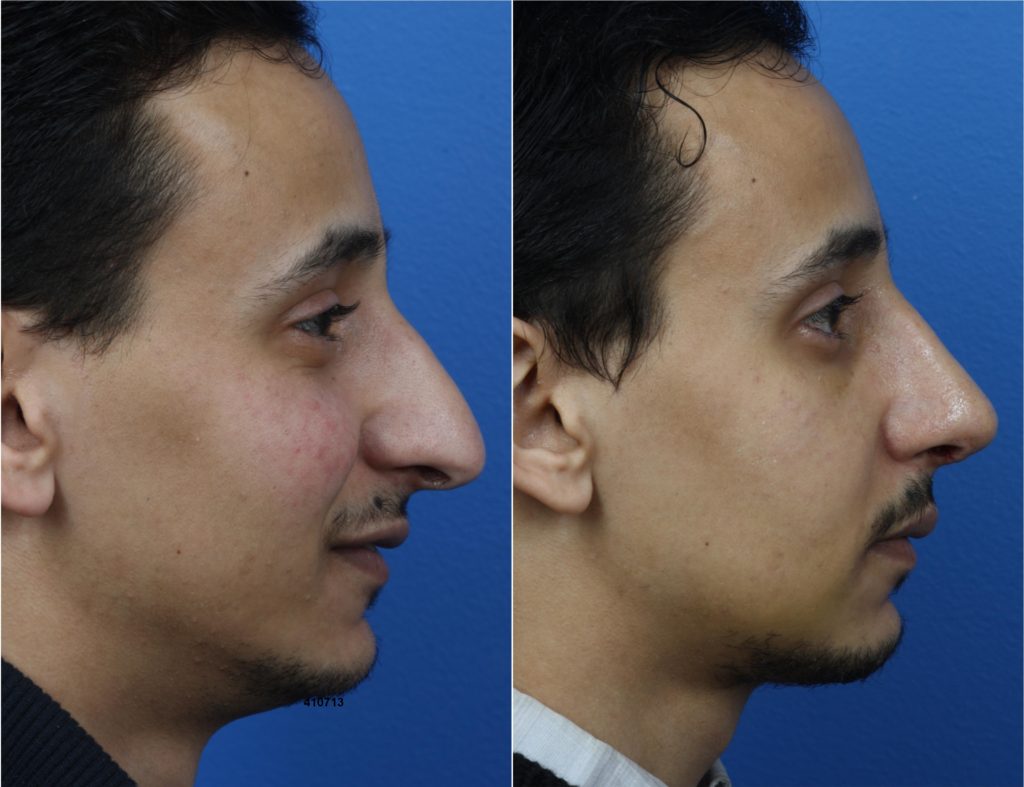
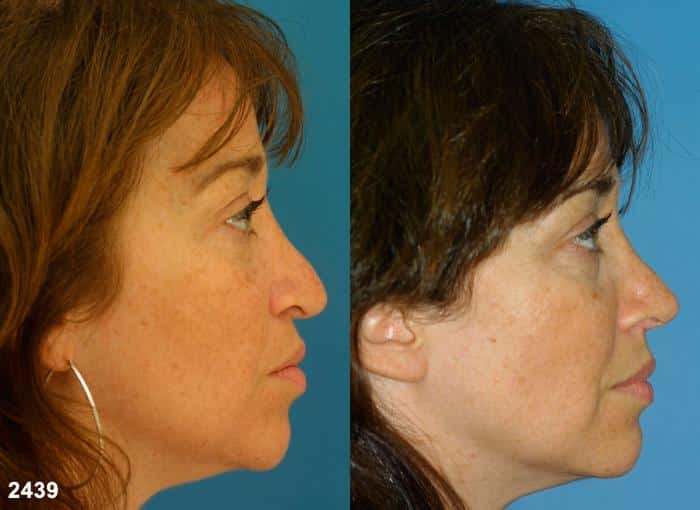
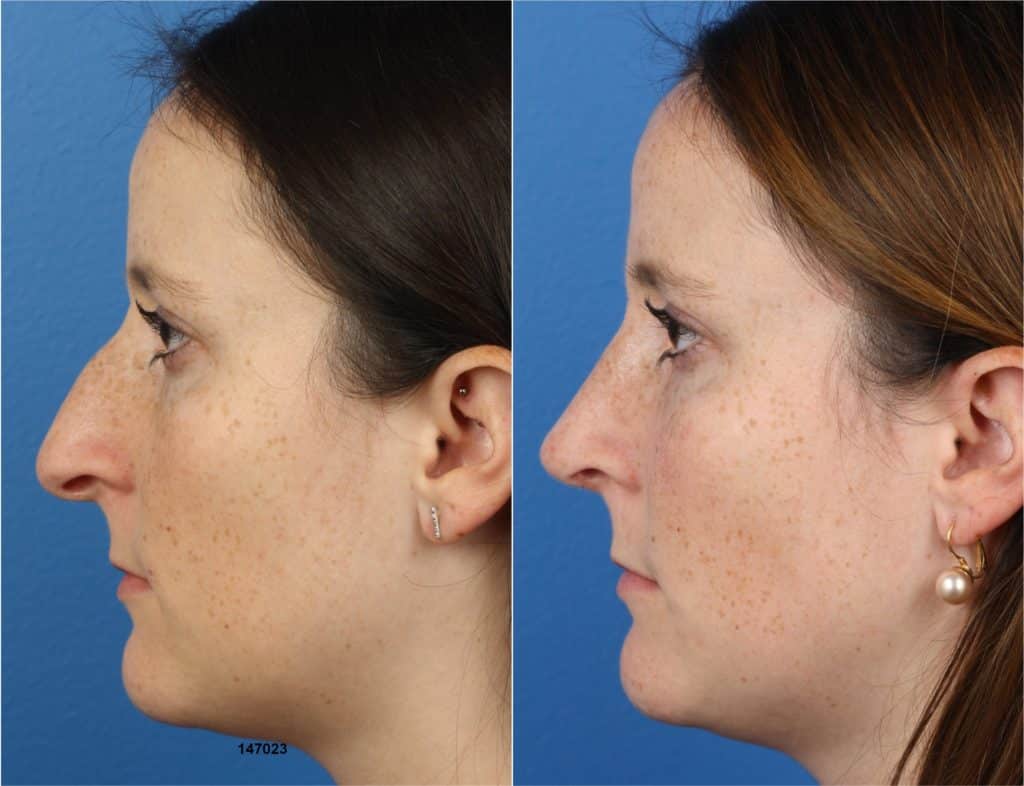
Upturned Tip
An upturned tip requires the opposite of the fix for a droopy nose. A nose derotation procedure lowers the upturned tip, decreasing the angle between the upper lip and the bottom edge of the nose. A tip refinement rhinoplasty can often address this issue without the need for a full rhinoplasty.
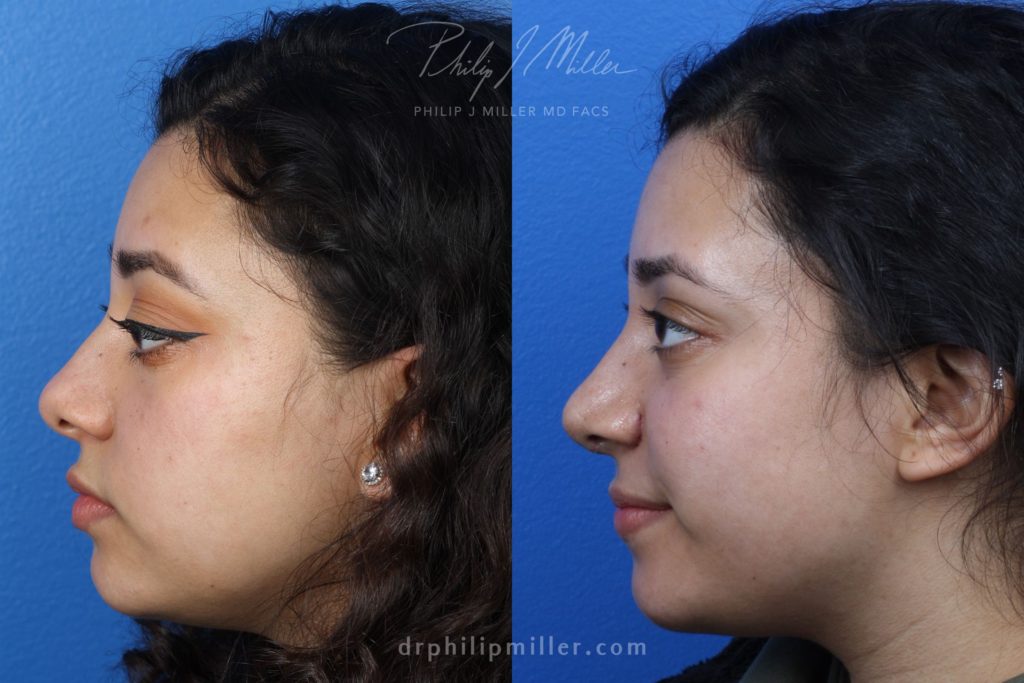
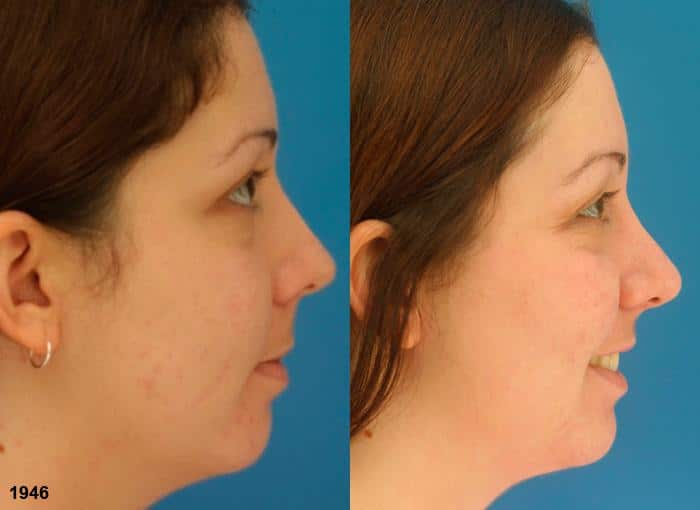
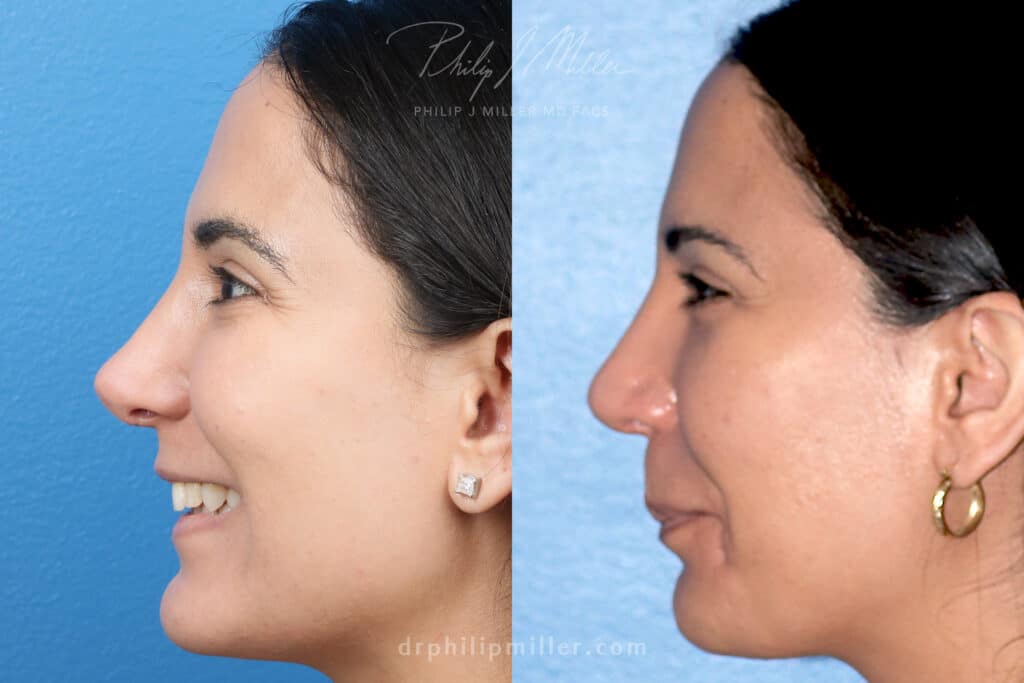
Bulbous Tip
A bulbous tip appears round, like a bulb on the end of the nose. Making this shape less circular and more pointed involves nose tip refinement. By altering the cartilage or using sutures to pull the nasal structure forward, Dr. Miller can resolve a bulbous tip and create a more aesthetically pleasing profile.
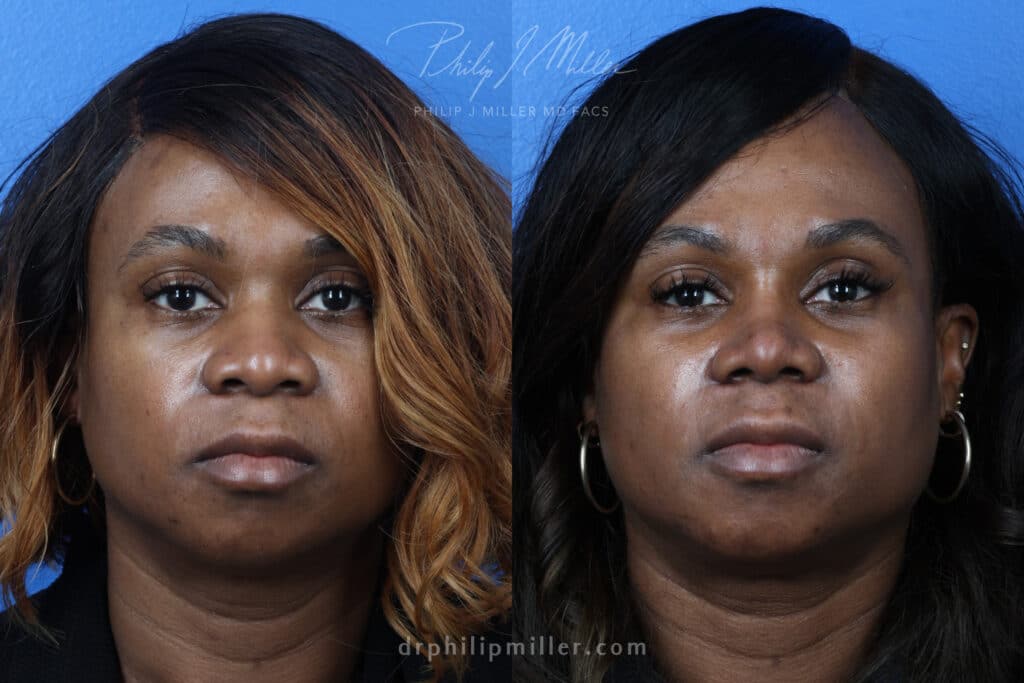
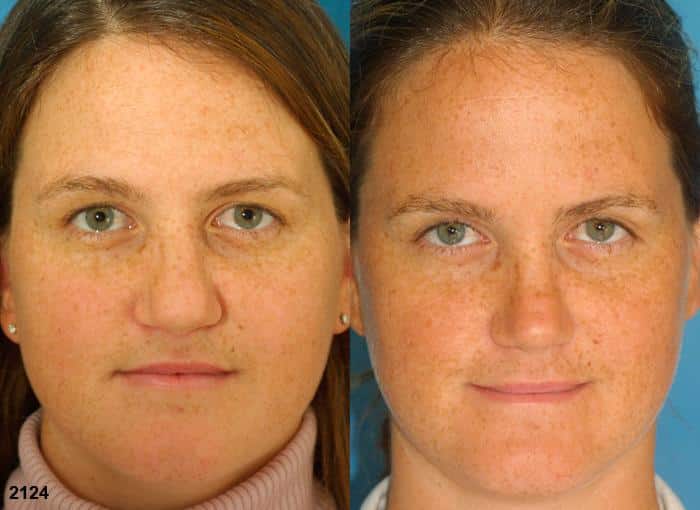
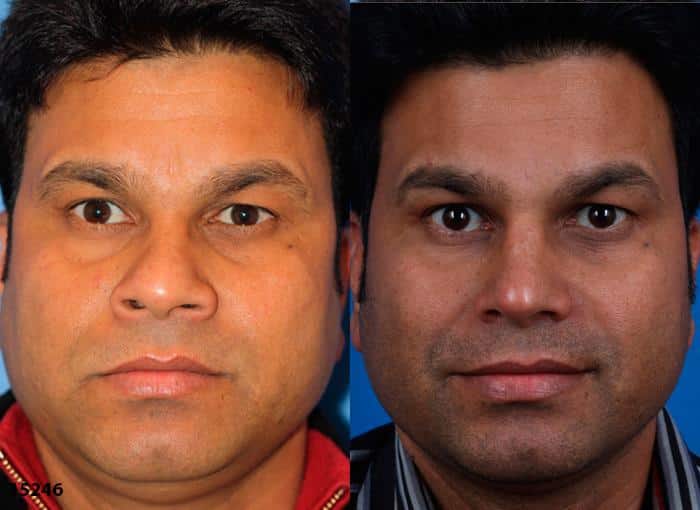
Overprojected Tip
An over-projected tip extends out farther than the average nose. Dr. Miller can effectively reduce the overall size of the nose to bring it into proportion with the rest of the facial features. To refine the tip of the nose, Dr. Miller may remove cartilage from the area. This creates a smaller projection that matches the visual goals of the patient. A full rhinoplasty may also be required to adjust the nasal bridge as well as the tip.
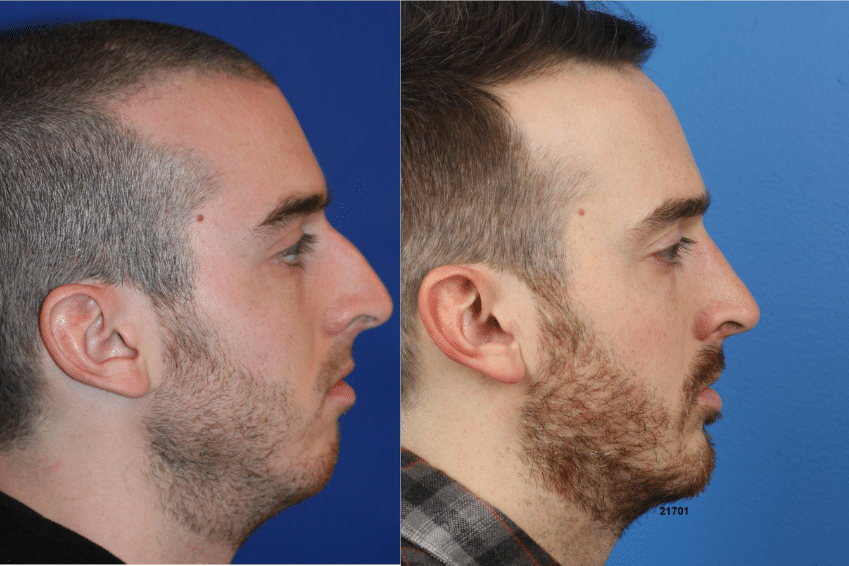
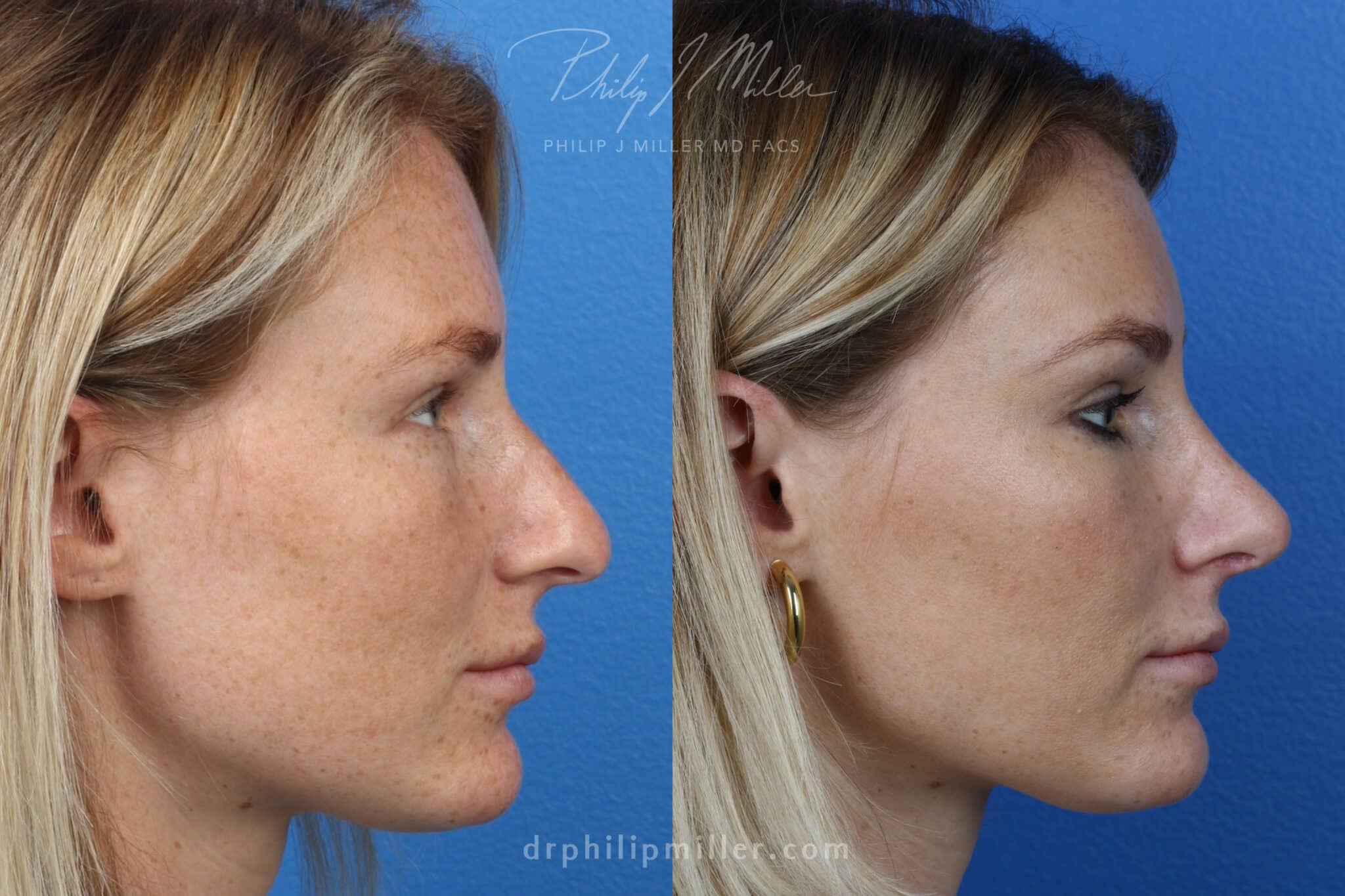
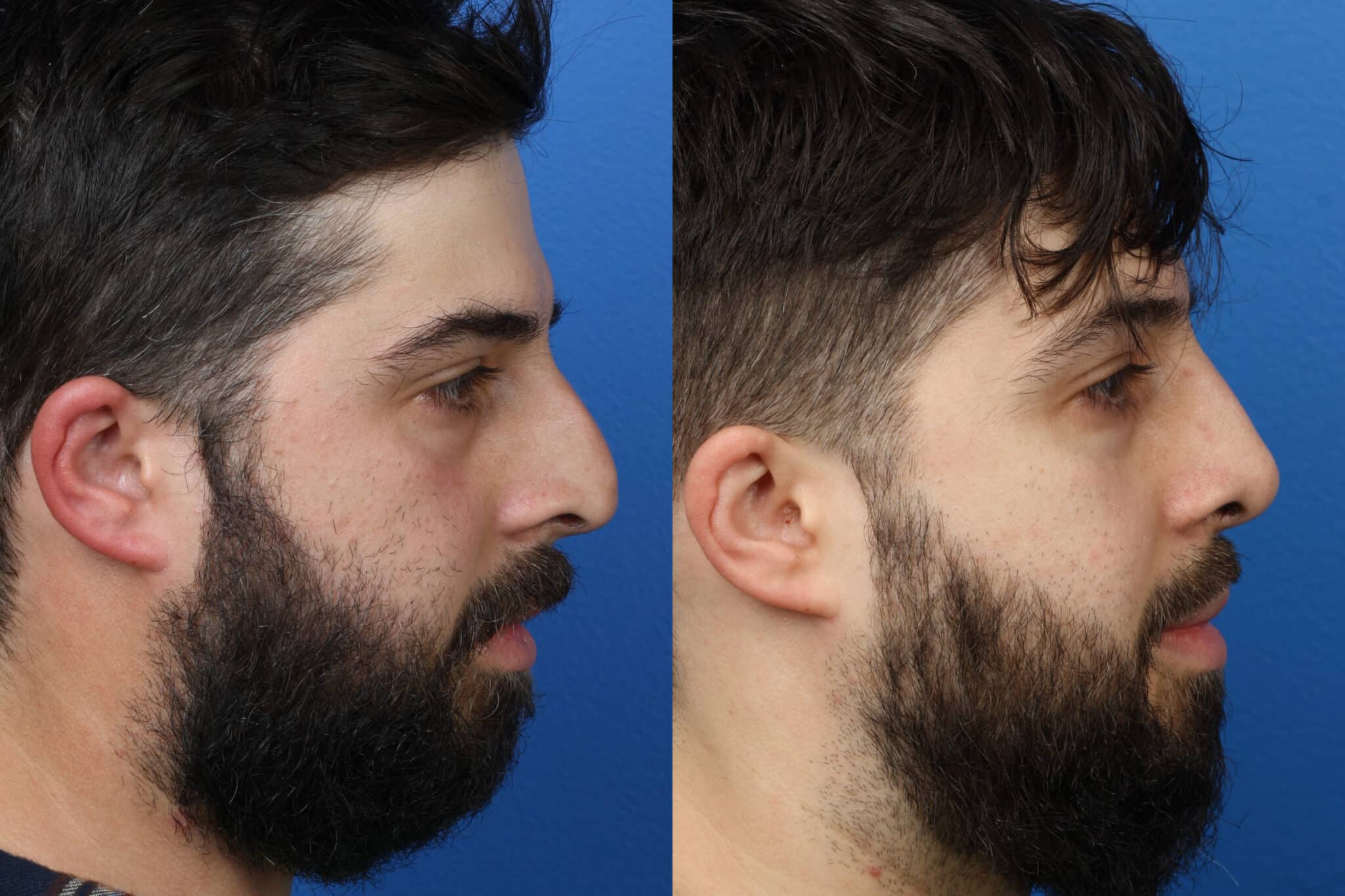
Wide Nostrils
Wide nostrils can create a broader base to the nose that may look out of proportion with the other facial features. Dr. Miller can effectively reduce the lower lateral cartilage to create smaller nostrils, and pull them forward to produce a better aesthetic. If you’re dealing with wide nostrils, rhinoplasty for tip refinement may be a great choice for you. If you have wide nostrils and other nasal structure issues that you’d like to have addressed, a full rhinoplasty would be a better option.
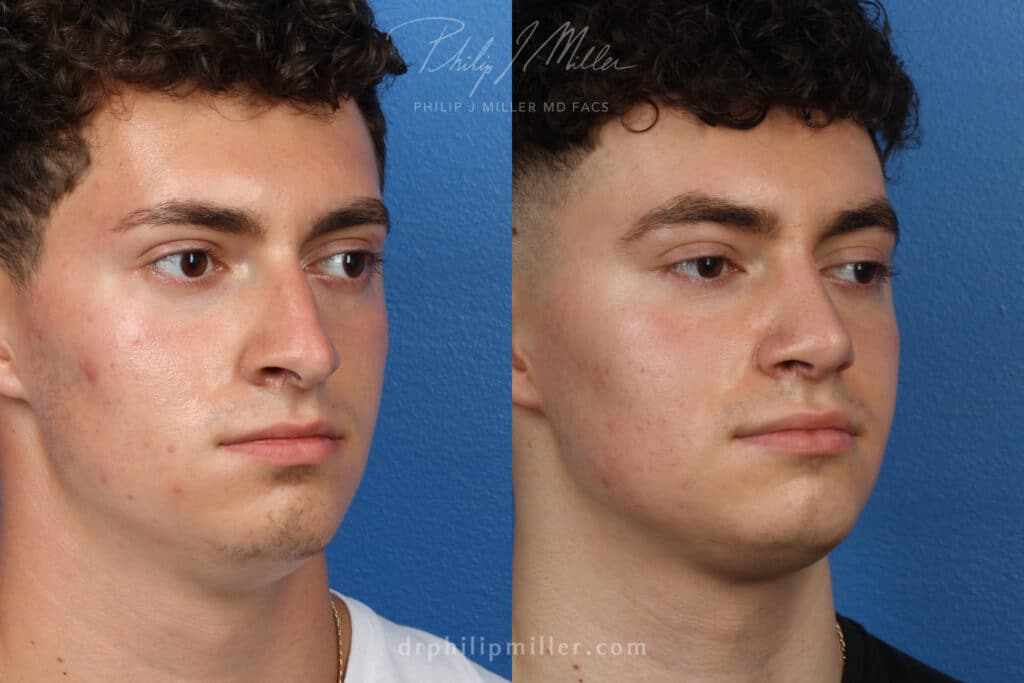
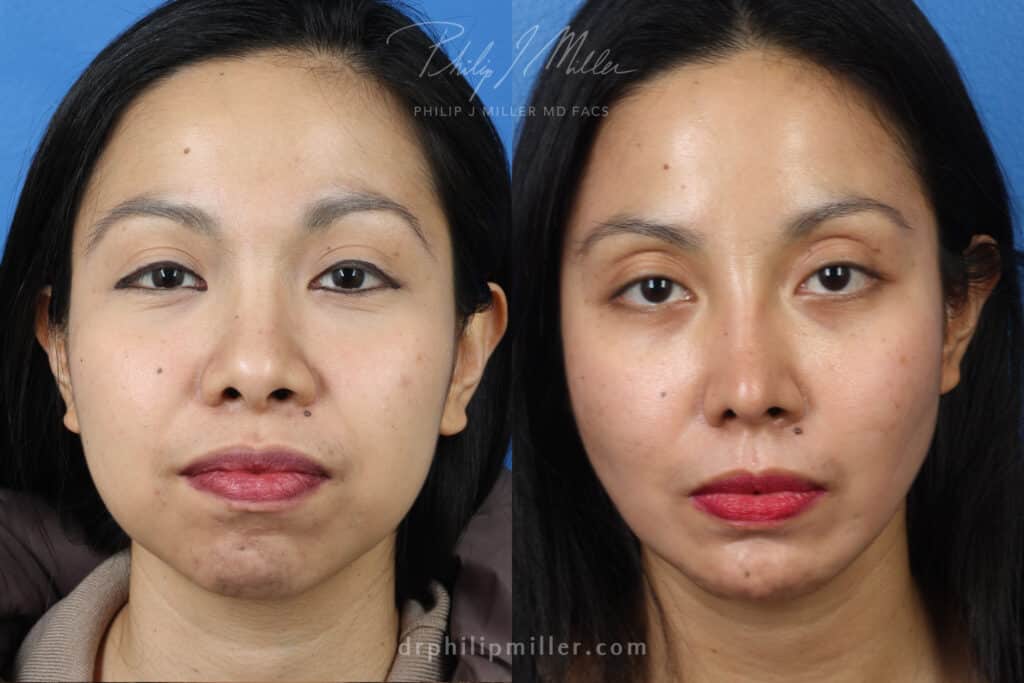
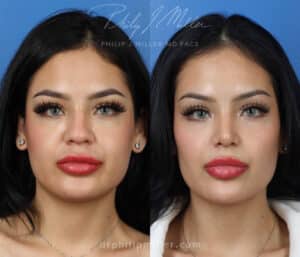
Benefits of Nose Tip Surgery
There are some benefits to choosing a refined tip rhinoplasty over a full rhinoplasty:
- Recovery time may be quicker
- Less bruising and swelling after surgery
- Tip of nose rhinoplasty might cost less
- Results last as long as full rhinoplasty
- Very satisfying results for the right patient
A nasal tip rhinoplasty may not be the right choice if you want correction to your nasal bridge or you have structural issues that impact your breathing. A consultation with an experienced rhinoplasty surgeon will help you determine the best approach for you.
Getting Nasal Tip Surgery in New York City
Philip J. Miller, MD, FACS, is a double-board certified facial plastic surgeon who has a wealth of experience and expertise in all types of rhinoplasty techniques. He will customize your surgery to ensure a harmonious, beautiful, and natural result.
Dr. Miller’s proprietary Natralook consultation process helps you achieve aesthetic confidence in a safe environment. By understanding your goals and discussing your needs, Dr. Miller can align your results with your expectations for a positive experience and outcome.
Contact his office in Manhattan, New York, or New Orleans, Louisiana, to schedule your consultation with him today.
Nose Surgery for Breathing
If you’re having trouble breathing due to a deviated septum or experiencing chronic sinus infections that don’t respond to over-the-counter medication, it’s time to schedule a consultation with a board-certified facial plastic surgeon. Nose surgery for breathing can improve your airway and help you live a healthier life.
Types of Nose Surgery to Breathe Better
Different types of nose surgery help patients breathe better, including rhinoplasty and septoplasty.
Rhinoplasty
If your nose is too small, it can cause airflow to become restricted, which can cause you to feel like you’re suffocating. If your nose is too large, it can cause your air passages to become narrowed, which can cause breathing to feel like you’re breathing through a straw. Both of these issues can be corrected with nose surgery (rhinoplasty).
Septoplasty
Septoplasty is another type of nose surgery that is used to correct a deviated septum. While a deviated septum is the most common structural irregularity, other obstructions can impede airflow and make breathing challenging. Septoplasty surgery realigns the walls between the two nostrils for balance and symmetry in the nasal cavities. In some cases, it might be necessary to combine septoplasty with turbinate reduction, which removes or reduces the bony, mucosa-lined outgrowths on the sides of each nostril for easier air passage.
Rhinoplasty vs. Septoplasty
Rhinoplasty and septoplasty are both nose surgeries for breathing but are not the same procedures. A septoplasty can be performed independently from a rhinoplasty procedure to realign the septum into the midline using an incision by the nostrils. The septum is separated from the mucosa and repositioned for improved breathing. A crooked nasal septum is known as a deviated septum, which blocks the nasal passage and obstructs breathing.
A deviated septum is an internal obstruction that many patients do not know they have but can cause symptoms such as:
- Snoring
- Sinusitis
- Breathing difficulties
- Sleep apnea
- Respiratory complaints
A septoplasty surgery has many benefits, including:
- Better breathing: It clears the nasal passage for uninterrupted breathing patterns.
- Improved sleep: Clear airways and consistent airflow allows for a quality night’s sleep without snoring or sleep apnea.
- Fewer sinus infections: Drainage improves when the airway is clear and reduces reoccurring sinus infections.
- Improved smell and taste: When the nose works properly and has aligned passageways, it makes smell and taste more powerful.
Rhinoplasty for breathing problems is a more comprehensive solution that can correct a variety of issues involving both function and appearance. A septoplasty is specifically used to treat a deviated septum, while rhinoplasty for breathing can correct other nasal obstructions, and address issues that impact the appearance of the nose.
Rhinoplasty for breathing can correct nasal support if one or both nostrils have a structural collapse that impedes breathing patterns. Before nose surgery for breathing, a detailed examination will determine the cause of impaired breathing and evaluate different nasal structures to identify the most effective course of action.
A rhinoplasty procedure can treat cosmetic or reconstructive needs that improve the appearance by reshaping, reducing, and adjusting the angle. Rhinoplasty is ideal for patients looking to correct the nose’s appearance and breathing complications. The shape and size of nostrils and a hooked or crooked nose can make breathing more complex and can be fixed with a rhinoplasty. With an expert plastic surgeon, rhinoplasty is a diversified surgery that can improve various symptoms that impact form and function.
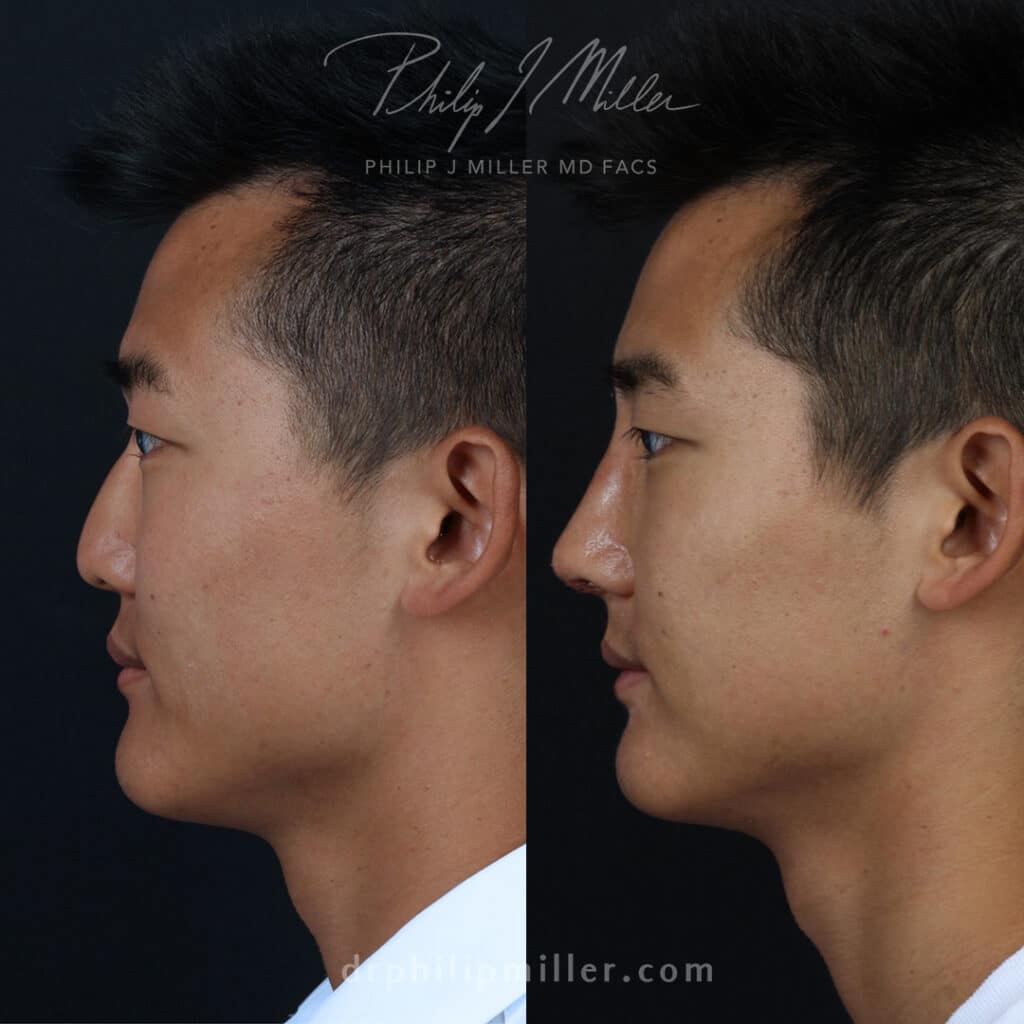
Considering nose surgery for breathing problems? Contact our office today
Rhinoplasty and septoplasty procedures are common plastic surgery procedures but are extremely complex and require an experienced, board-certified surgeon. Phillip J. Miller, MD, FACS, is a world-renowned double board-certified facial plastic surgeon with more than two decades of experience. He specializes in rhinoplasty procedures and has executed thousands of successful cosmetic and reconstructive nasal surgeries.
Dr. Miller uses the Natralook® process to evaluate and design a treatment plan to give patients more aesthetic confidence. It is an empowering process that creates a safe and supportive space for patients to discuss concerns and desires and prepare a unified vision between Dr. Miller and patients.
If you are interested in nose surgery for cosmetic or functional reasons, we can help. Contact us to schedule a consultation at our New York City or New Orleans office and learn more about nose surgeries for breathing.
What Is the Best Age for a Nose Job?
The best age for a nose job will depend on a variety of factors, including the patient’s reason for seeking the procedure. Although there are no concrete age guidelines, this overview can help you determine whether now is the right time to pursue nose surgery.
Rhinoplasty is the surgical reconstruction of the nose. In nose surgery, doctors reshape the nose by removing excess tissue, correcting crooked cartilage, and augmenting the nose to improve its appearance. The type of rhinoplasty procedure performed depends on the results you hope to achieve and the unique characteristics of your nose.
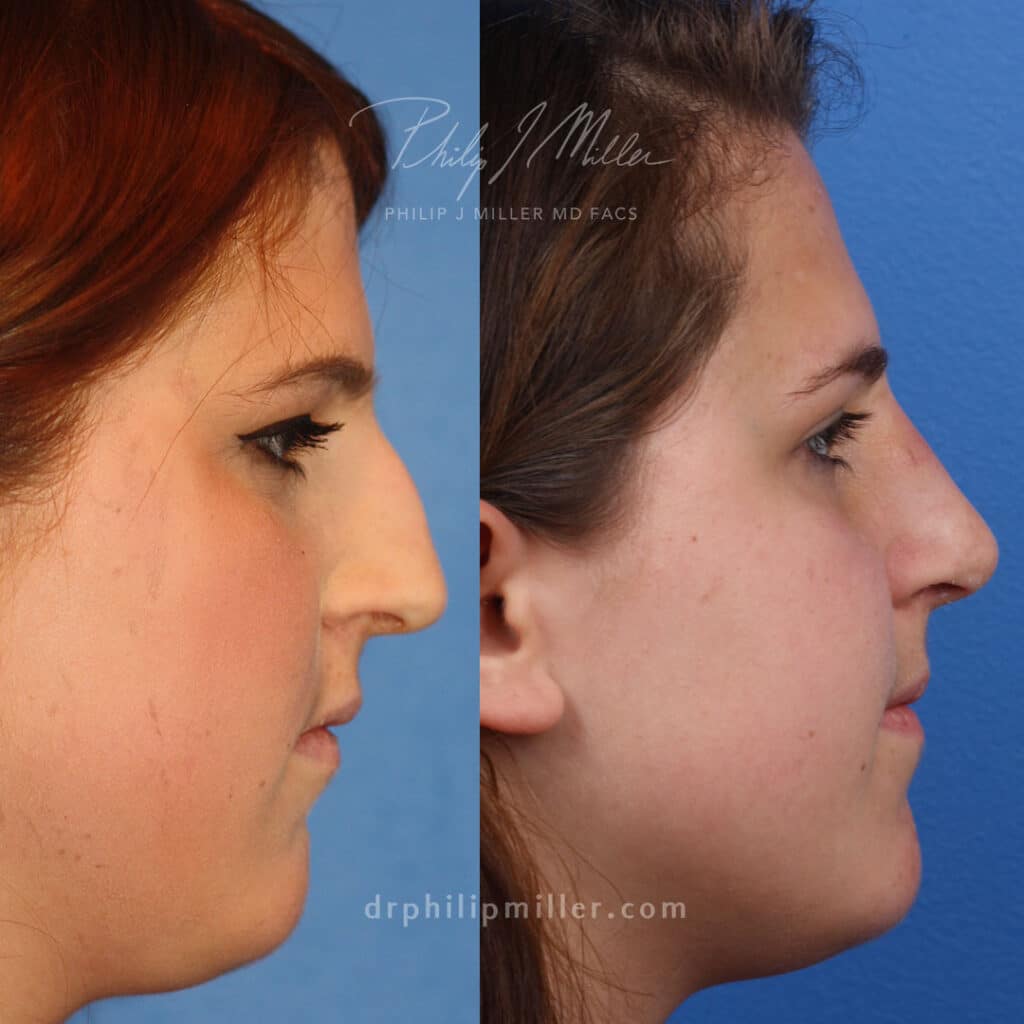
There are also medical reasons an individual may choose to have a nose job. The nose is a complex structure that plays an important role in the health and well-being of the body. The nose is responsible for airflow into and out of the mouth, which is essential for breathing, eating, and talking. The nose also plays a critical role in the sense of smell.
The nose has both cosmetic and medical functions that require surgical corrections. Many young patients feel insecure about their noses and seek rhinoplasty for cosmetic reasons. But how young is too young for a rhinoplasty procedure?
At what age can you get a nose job?
There are no concrete age requirements for a rhinoplasty procedure, but many surgeons suggest waiting until around 18 years old for a nose job to ensure facial features are fully developed.
Facial features mature at different rates and patients have different reasons for a rhinoplasty procedure. This is why speaking with a board-certified expert rhinoplasty surgeon who can evaluate your nose and give you a personal recommendation is so important.
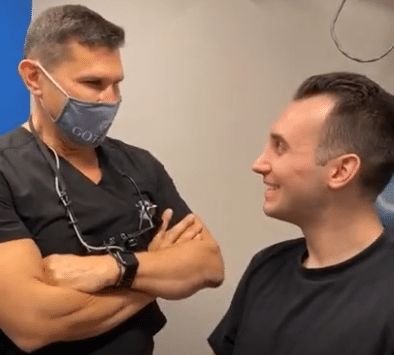
Can I get a nose job at 14, 15, 16, or 17?
Yes, teenage patients can get a nose job between the ages of 14-17 in some circumstances. However, a cosmetic rhinoplasty procedure for 14-17 year-olds is less common because their facial features may still be changing. In the younger age group, a medical rhinoplasty is more common to fix issues like a cleft palate or breathing problems.
A rhinoplasty procedure for young patients should be an open discussion between the patient, parents, and the plastic surgeon. Outside of facial maturity for the process, it is essential to consider emotional maturity to understand the life-changing effects of a nose job. Rhinoplasty surgeries are complex procedures that require significant recovery. Final results can take up to one year and requires patients to follow careful post-operative instructions to ensure an optimal outcome.
Boys and girls reach facial maturity at different ages. Girls typically have full development around 14-15, while boys don’t tend to fully mature until around 16-18. It is a very individualized decision that is less about age and more about developmental and emotional maturity.
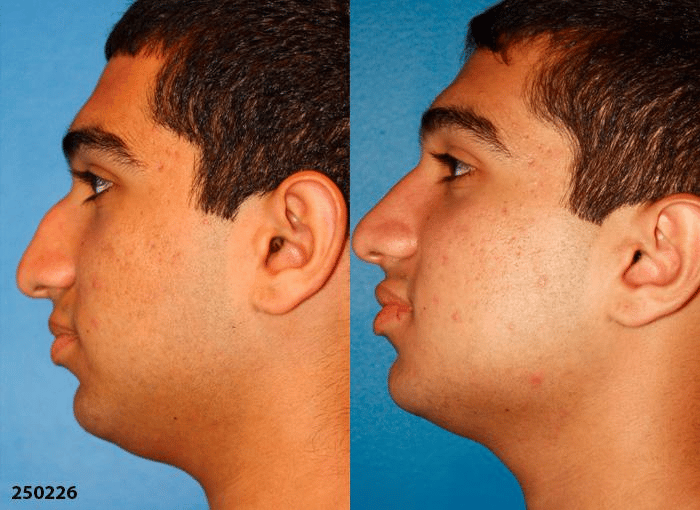
Philip J. Miller, MD, FACS, is double board-certified facial plastic surgeon specializing in rhinoplasty procedures and facial rejuvenation. With more than two decades of experience, Dr. Miller provides customized and innovative care to all patients. When it comes to teenage rhinoplasty patients, he is very conservative in his approach to evaluating candidates. Expectations are critical when determining if a young patient is ready for the procedure.
Dr. Miller assumes professional responsibility for involving parents in a thorough assessment of psychological and developmental maturity. In some cases, Dr. Miller asks trusted psychologists to help during the process to ensure a comprehensive evaluation of each patient. Teens that move forward with surgery can expect many benefits from working with an expert, including:
- Improved self-confidence
- Better health and structural harmony
- Comfortable breathing
- Natural results
Dr. Miller uses the Natralook® procedure to help patients explore their aesthetic confidence. It is an enriching process that provides a safe and supportive space to discuss personal challenges and desires. For any patient, regardless of age, it is essential to work with a surgeon that has a unified vision and experience creating natural results.
Are you thinking about rhinoplasty? Contact us to schedule a consultation and learn more about teenage rhinoplasty procedures.
Surgical or Liquid (Non-Surgical) Rhinoplasty: Which one is right for me?
When it comes to getting a nose job, there are two basic options: surgical or non-surgical. Surgical rhinoplasty requires anesthesia, incisions, and downtime, but produces permanent improvement. A non-surgical rhinoplasty, commonly known as a liquid rhinoplasty, is a less invasive option that utilizes injectable fillers to temporarily change the appearance of the nose.
When considering a rhinoplasty, it is essential to realize that different types of rhinoplasty procedures are used, depending on the severity of alterations. Individualizing a rhinoplasty procedure ensures that results are natural and balanced to your unique facial features.
What is liquid rhinoplasty?
Liquid rhinoplasty is a non-surgical alternative to a surgical rhinoplasty procedure that uses injectable dermal fillers to make the nose more appealing. This less invasive option may produce pleasing results with a quicker approach and less recovery time.
Juvederm® and Restylane® are two common dermal fillers used for liquid rhinoplasty. Juvederm is an FDA-approved volume enhancer containing hyaluronic acid, a naturally occurring substance in the body. Restylane is another hyaluronic acid injectable that restores and rejuvenates the skin. These fillers can add hydration and volume to the nose and alter the shape for a more appealing appearance.
Even though liquid rhinoplasty is not a surgical procedure, it still requires skill and experience to inject the filler into the correct area for intended results. The process is quick and patients can return to normal daily activities after the injection. It is an effective alternative with many benefits, including:
- Non-invasive
- Minimal downtime
- Safe and effective
- Instant results
- Smoother nose shape
- More balanced appearance
What’s the difference between liquid and regular rhinoplasty?
Surgical and liquid rhinoplasty are two very different procedures with different processes, results, recovery, costs, and expectations. Take a look at the breakdown:
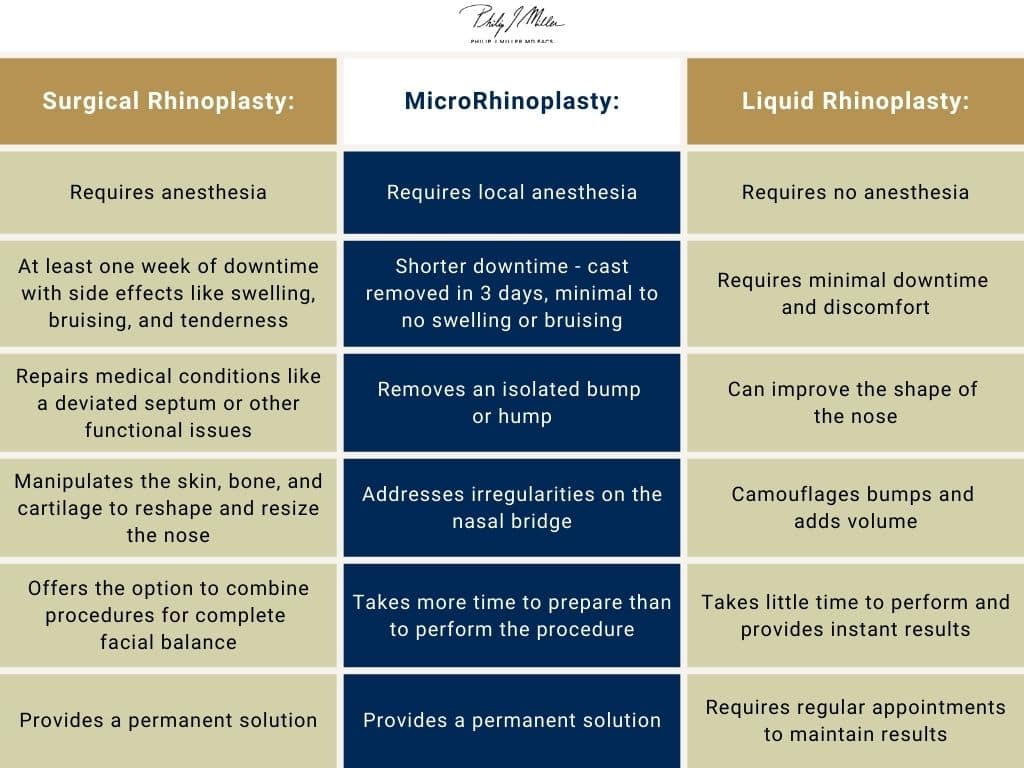
Surgical Rhinoplasty:
- Requires anesthesia
- Manipulates the skin, bone, and cartilage to reshape and resize the nose
- Repairs medical conditions like a deviated septum or other functional issues
- Requires downtime of at least one week before returning to work and daily activities
- Is associated with side effects like swelling, bruising, and tenderness
- Provides a permanent solution
- Offers the option to combine procedures for complete facial balance
Liquid Rhinoplasty:
- Is minimally invasive
- Requires minimal downtime and discomfort
- Can improve the shape of the nose
- Camouflages bumps and adds volume
- Takes little time to perform
- Provides instant results
- Is associated with minimal swelling, bruising, and tenderness
- Requires regular appointments to maintain results
How much does liquid rhinoplasty cost in NYC?
The cost of rhinoplasty procedures varies by patient and depends on the treatment plan. Non-surgical rhinoplasty costs typically range from $300-$1300 per treatment. Some of the factors that impact price include:
- Type of dermal fillers used
- Number and amount of filler injected
- Experience and expertise of injector
It is also important to understand that liquid rhinoplasty is not a permanent solution and requires regular appointments to maintain the desired shape. Patients can learn more about the specific costs of liquid rhinoplasty during a consultation with Dr. Miller.
@drphilipjmiller #liquidrhinoplasty ! In 10 minutes, no down time, you will have a new nose that last about 2 years. Call today and book a session with me! #nonsurgicalrhinoplasty ♬ original sound – Sam Smith
How much does surgical rhinoplasty cost in NYC?
Surgical rhinoplasty encompasses a wide range of possible alterations and additional steps, such as a graft or implant. Due to the variance in procedure possibilities, there is also a wide range of costs. An average surgical rhinoplasty procedure in New York City ranges from $3,500-$25,000. During a consultation, Dr. Miller will explain the treatment plan and expected costs.
How long does liquid rhinoplasty last?
Unlike a surgical rhinoplasty, liquid rhinoplasty is not a permanent solution. This treatment requires regular appointments to maintain your pleasing results. Results vary by patient depending on how many dermal fillers were used, where they were injected, and the level of correction required. Many patients see results for around 18 months before needing a touch-up session. Dr. Miller and his expert team will evaluate your nose and treatment plan for a suggested maintenance schedule to keep a natural and well-balanced nose shape.
How long does surgical rhinoplasty last?
Surgical rhinoplasty is a permanent procedure that has lifelong results. Once the nose is reshaped and altered, it will remain in its new state with proper care.
Which one is better: surgical or non-surgical rhinoplasty?
Both procedures are practical and effective solutions, depending on the patient’s specific needs and desires. Philip Miller, MD, FACS, strives to help patients achieve aesthetic confidence and natural results using the NatraLook® process. During your consultation, Dr. Miller discusses your concerns and expectations to identify which procedure is right for you and create a unified treatment plan.
Dr. Miller is a double board-certified surgeon in facial plastic and reconstructive surgery and head and neck surgery. He is a world-class surgeon and leading expert in rhinoplasty and facial rejuvenation. With more than 20 years of expertise, Dr. Miller works closely with patients to identify their needs and desires to create unmatched results.
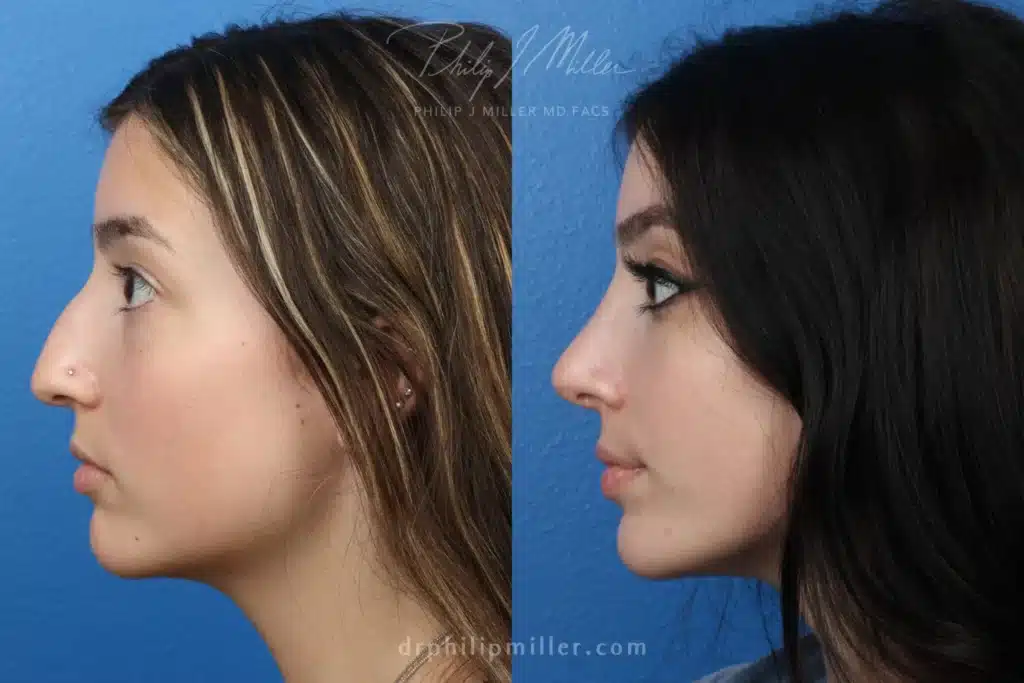
Contact us to schedule a consultation and learn more about which rhinoplasty procedure is right for you.
Nose Taping After Rhinoplasty
Nose taping is a common practice among rhinoplasty patients. It is a bandage or tape used during rhinoplasty recovery to support the nose, decrease swelling, and improve the nose’s appearance. Philip Miller, MD, FACS, often recommends nose taping to enhance a patient’s healing process after nose surgery, provided it’s done correctly.
What are the benefits of nose taping after rhinoplasty?
Nose taping after rhinoplasty is beneficial for many reasons. The primary benefit is that it helps to decrease swelling fluctuations after the procedure. It also helps improve:
- Bruising
- Bleeding
- Breathing
- Healing process
- Final appearance
Some patients choose to tape their noses daily or multiple times per day to help them feel better. However, it is most commonly recommended at night when swelling is most likely to occur. It is not necessary to tape during the day unless specified by Dr. Miller.
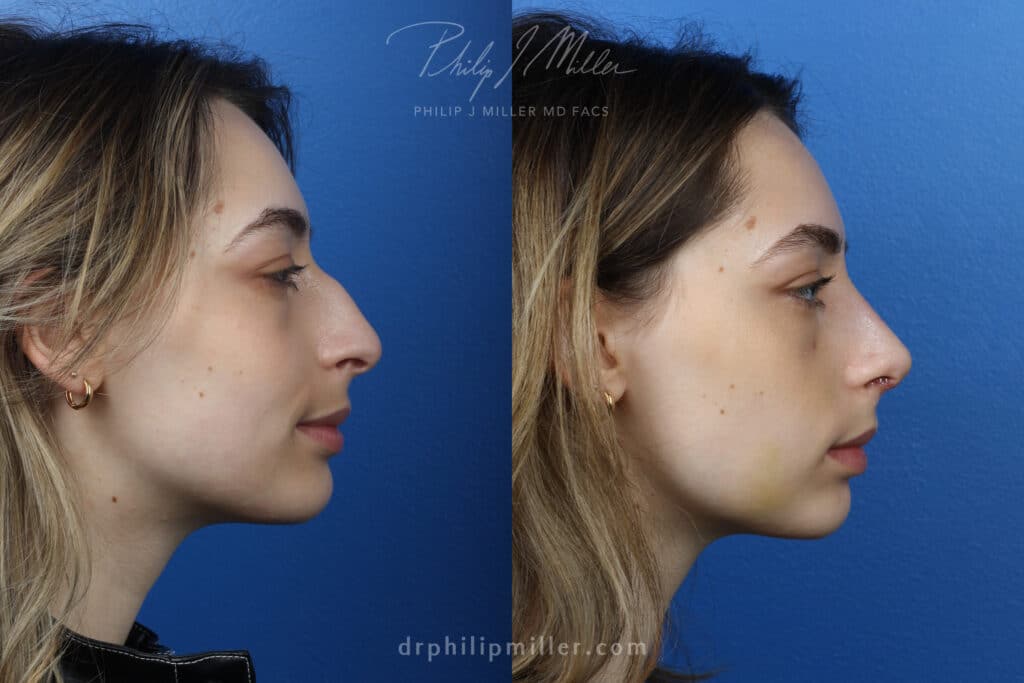
What if I don’t tape my nose after rhinoplasty?
Not all patients have to tape their nose after rhinoplasty surgery; it should only be done following instructions from a skilled board-certified facial plastic surgeon. Dr. Miller works closely with each patient to determine the benefit and necessity of nose taping. There are cosmetic and health benefits associated with taping. If the nose taping process is not followed as directed, it could lead to:
- Nose deformity
- Extended healing time
- Additional complications
- Increased swelling
How to Tape Your Nose after Rhinoplasty
There are multiple kinds of tape to use after rhinoplasty. Common choices are adhesives, like medical tape and bandages, and those that use pressure, like dental bandages. Speak to your surgeon about taping instructions best suited for your situation and healing expectations. Generally, patients should:
1. Tape the nasal bridge: Use 3-5 strips of tape about two inches long. Start at the tip of your nose and overlap upward to cover the entire bridge.
2. Wrap the tip: Use a longer piece of tape to wrap the end of the nose, creating a “U” shape while avoiding the nostrils.
3. Repeat the first step: Repeat the first step using strips to cover the bridge and ensure the “U” tape stays in place.
At first, nose taping may be necessary 24/7, depending on your specific circumstances. In this case, the tape should be removed every 2-3 days and new tape applied. After several days or weeks, nose taping may only be done at night to help with swelling and removed each morning.
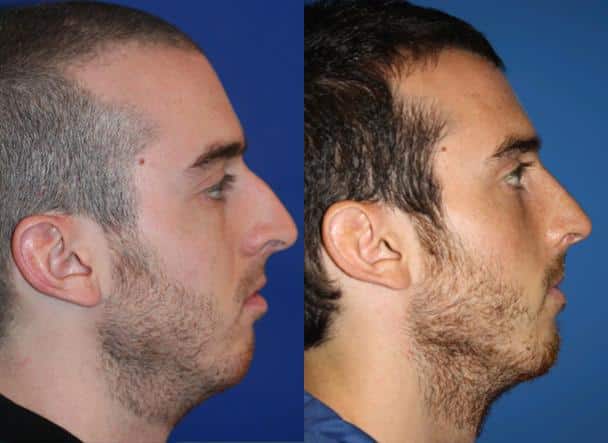
Removing tape should be done with as much care as applying the tape to prevent any harsh movements or pressure. Tweezers can be used to gently peel the tape or remove it after a shower when it is damp and starting to lose adhesiveness, or apply baby oil on the tape and that will loosen it.
How long should I tape my nose after rhinoplasty?
Nose taping is often recommended for 1-3 months after a rhinoplasty procedure. Dr. Miller provides patients with clear instructions for recovery care and taping. Patients will also visit Dr. Miller for follow-up appointments to ensure proper healing and appearance.
Schedule Your Nose Job in NYC
Dr. Philip Miller, MD, FACS, is a world-class, double board-certified plastic surgeon and a leading expert in rhinoplasty procedures and facial rejuvenation. Dr. Miller has more than 20 years of experience in surgical and non-surgical facial procedures and an artistic eye for helping patients meet their cosmetic goals. After a rhinoplasty or revision rhinoplasty procedure, may instruct patients to tape their nose, but it is not always recommended.
Dr. Miller is an innovative expert that offers personalized care and treatment plans. His goal is to empower patients and support aesthetic confidence. Dr. Miller uses the NatraLook® Process to create a positive environment where patients can discuss obstacles and desires for a unified and natural rhinoplasty result.
Contact us to schedule a consultation and learn more about nose taping after rhinoplasty.
Do I Need a Spreader Graft?
Spreader grafts are a common technique used in rhinoplasty and rhinoplasty revision. They are grafts of cartilage placed between the upper lateral cartilages and the septum to widen the middle third of the nose. These grafts assist with vestibular stenosis and help prevent depressions and concavity in the middle third of the nose.
Dr. Philip Miller is a double board-certified facial plastic surgeon in facial plastic and reconstructive surgery and head and neck surgery located in the heart of Manhattan. Dr. Miller specializes in cosmetic facial procedures and is a leading expert in rhinoplasty and facial rejuvenation. Dr. Miller and his highly acclaimed team offer customized treatments in New York City, NY, and New Orleans, LA.
Do I need a spreader graft?
A spreader graft may be useful during a variety of rhinoplasty procedures, including the following:
When a hump is removed, a spreader graft is used to strengthen and support the middle third of the nose. The hump contains delicate connections of cartilage and bone, so removing it increases the risk of the nose falling inward. Spreader grafts prevent a concave nose by adding structural support.
If there is a bend in the middle of the nose, it can be corrected with a spreader graft. In this case, the graft addresses the asymmetry of the nose and may improve the airway passages for easier breathing.
Nose trauma or a previously failed surgery can lead to depression in the middle third of the nose. A spreader graft can provide adequate support to the nose and rebuild the dorsum.
Patients that have medical issues and require better airflow can use a spreader graft to improve the internal nasal valve, the narrowest part of the nasal airway.
What is spreader graft in rhinoplasty?
During a rhinoplasty or rhinoplasty revision, a spreader graft is used to correct a specific problem. It is typically used to fix functional issues, like breathing, in the middle section of the nose between the nasal tip and below the nasal bone. In rhinoplasty, a spread graft is used to add support to the nose after a hump reduction or open the internal nasal valve for better breathing.
While the practical uses are ideal for breathing improvements, a spreader graft can also help solve cosmetic issues. A spreader graft can correct a twisted nose by only placing the graft on one side of the nose to straighten it. They can also be used in rhinoplasty revision to keep the septum straight. In some cases, they restore support that might have been lost after the initial rhinoplasty procedure.
Benefits of a Spreader Graft
A spreader graft offers many benefits, including:
- Permanent solution for functional and cosmetic problems
- Improves airway passage
- Provides structural support for long-lasting rhinoplasty results
- Balanced nose shape that is harmonious with other facial features
- Prevent future problems and revision surgeries
About the Procedure
A spreader graft can be placed during an open or closed rhinoplasty procedure. The best option is during an open rhinoplasty so that surgeons have a clear view of the treatment area for accurate placement. The actual graft is made from the patient’s cartilage, usually from the septum or ear, if the septum cartilage is minimal.
The spreader graft is usually placed on both sides of the septum to widen the internal nasal valve. The graft is sewn into place with sutures, and then the upper lateral cartilage is put back into place for the middle vault reconstruction. It is an extensive surgical procedure that requires anesthesia and adequate recovery time.
Like any rhinoplasty procedure, performing a spreader graft requires extensive recovery before final results are evident. The graft placement itself is vast and can take up to 3 hours depending on if it is a combination procedure. Any incisions are minor and heal quickly with minimal scarring. Many patients have bruising and swelling for several weeks after the surgery and can expect most of the swelling to subside within a month or two. However, it can take up to a full year before swelling is gone entirely.
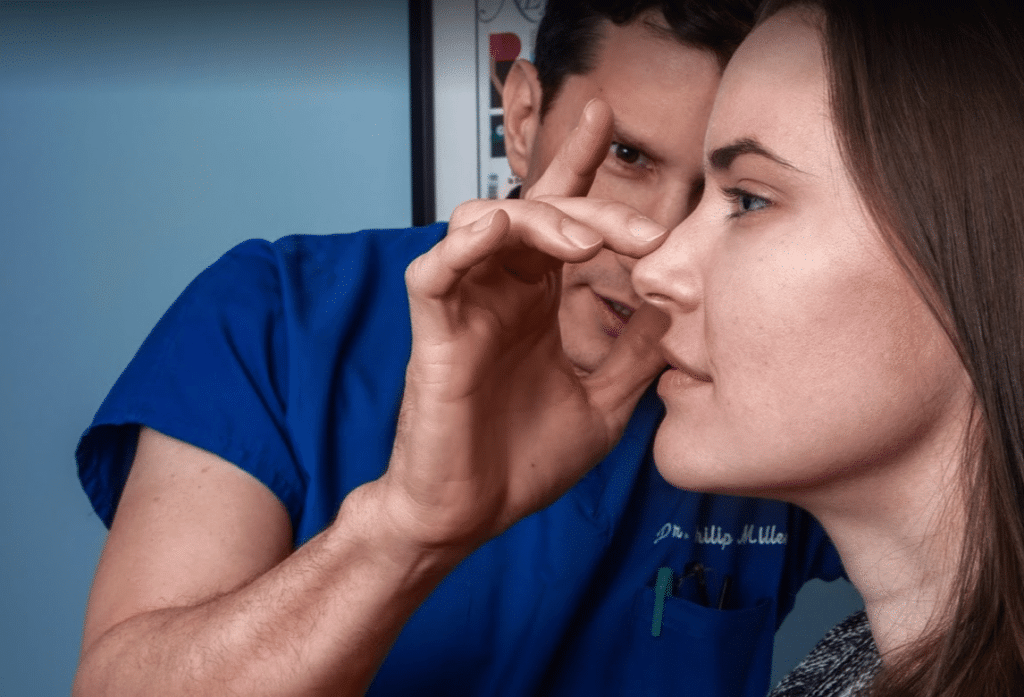
Spreader grafts before and after
In some cases, a spreader graft does not add any cosmetic value to the nose and does not produce visible outward changes. When used to improve nose function, the changes are only internal and will be apparent to the patient with better breathing.
When spreader grafts are used to add support and change the shape of a nose, there are noticeable outward changes after surgery. A spreader graft can result in dramatic changes when a nose is collapsed or twisted.
Spreader grafts in Manhattan, NYC
Dr. Miller is a top plastic surgeon in New York City and New Orleans with more than 20 years of experience and thousands of successful surgeries. Dr. Miller and his team strive to create stunning and natural results with NatraLook®. The NatraLook process expands the typical plastic surgery experience into a safe opportunity to explore aesthetic confidence. Patients work closely with Dr. Miller to create a unified vision and work through obstacles to achieve natural results.
Contact us to schedule a consultation and determine if spreader grafts are right for you.
Endonasal Rhinoplasty
Dr. Miller never uses a “cookie-cutter” or one-size-fits-all approach to nose surgery. Because every patient is unique in their facial features, your consultation will determine which surgical approach is best for your particular circumstances. Double board-certified facial plastic surgeon Philip J. Miller, MD, FACS, performs both closed rhinoplasty (endonasal) or open rhinoplasty depending on the specific needs of each patient.
Dr. Miller offers patients in Manhattan, New York, and New Orleans, Louisiana, expert rhinoplasty techniques, with the goal of bringing balance to your facial features and achieving beautiful, natural-looking results.
What is endonasal rhinoplasty?
Also called a closed rhinoplasty, endonasal rhinoplasty is an internal procedure in which all incisions are confined to inside the nostrils. The nose is not opened fully, and the nasal structure is not exposed. The work is done entirely through narrow openings in each nostril. Patients concerned about visible scarring need not worry with a closed rhinoplasty. During the procedure, Dr. Miller carefully lifts the underlying bone, cartilage, and tissue through the nostrils, so you won’t be able to see any scarring.
Open vs. Closed Rhinoplasty
While both open and close rhinoplasty procedures can achieve exceptional results, each has its own advantages and drawbacks to consider during your consultation.
During an open rhinoplasty, Dr. Miller makes a small incision in the columella – the piece of tissue that separates the nostrils at the base of the nose. Also called external rhinoplasty, this technique opens the tip of the nose to reveal the internal structure. Dr. Miller can reshape the nose and repair damage while keeping structural support intact. An open rhinoplasty provides improved precision, enhanced visibility, and enhanced structural support. However, there can be minor scarring under the base of the nose. An open rhinoplasty may also require a slightly longer recovery process compared to a closed technique.
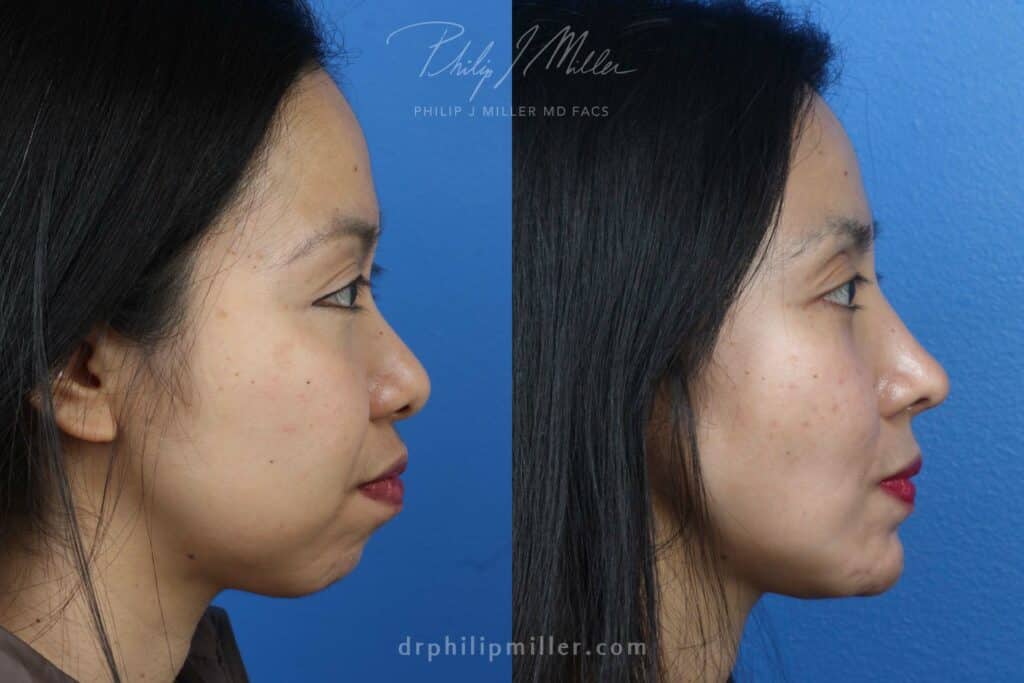
Dr. Miller typically recommends open rhinoplasties for patients with complex structural concerns, such as a severely crooked nose, nasal trauma or deformities, an asymmetrical tip, a large nasal tip, or a large dorsal hump (bump on the nasal bridge). For these patients, the possibility of a nearly imperceptible scar is a good trade-off for the most natural nose reshaping possible.
A closed rhinoplasty is especially appealing for those who want to make minor modifications to their nose. Dr. Miller might also recommend this approach if you have breathing problems, such as chronic sinusitis. It is a more conservative type of rhinoplasty, which means it may not produce the more dramatic results achieved with an open rhinoplasty.
The closed technique is ideal for minor adjustments to the nasal tip and bridge. If you have a dorsal hump, wide nasal bridge, or enlarged nasal tip, endonasal rhinoplasty can deliver subtle results with little impact on the surrounding tissue.
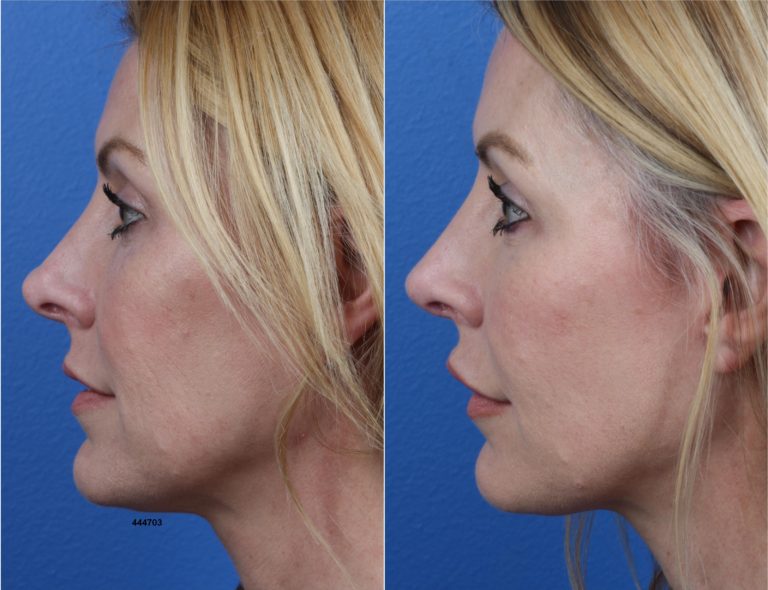
Benefits of Endonasal Rhinoplasty
Because all stitches are located inside the nose, patients will not have any visible scarring after the surgery. Recovery may also be a bit faster, with many patients returning to work and other activities within one week rather than the two weeks usually allotted for open rhinoplasty recovery. Other benefits include:
- Decreased operative times
- Profile adjustments are easier to judge because the structural support remains undisturbed
- Reduced postoperative edema
- Quicker return to a normal appearance
How is Endonasal Rhinoplasty Performed?
You can undergo endonasal rhinoplasty using local anesthesia with sedation or general anesthesia. To begin, Dr. Miller will make incisions inside the nostrils to separate the skin from the cartilage. Dr. Miller can then begin the process of reshaping the cartilage or shaving off or adding bone (bone graft) through the narrow openings in each nostril. Once the shaping is complete, absorbable stitches will close any incisions. You will have a cast or nose splint after surgery to protect the nose and maintain the new shape. The procedure typically takes 1-2 hours to complete.
Recovery After Endonasal Rhinoplasty Surgery
You will need to arrange for someone to drive you home after your surgery. The cast or splint helps support the nose as it heals for the first week. You can expect to take a few days off from work so you can comfortably recover at home. It is best to keep your head elevated to help reduce any swelling. To ensure faster healing, avoid the following:
- Strenuous exercise/activity
- Blowing your nose
- Swimming
- Sleeping facedown
- Excessive chewing
- Drinking alcohol
- Smoking
- Wearing eyeglasses
- Pulling tight clothing over your head
We will remove your cast or splint after one week. You can usually return to work and normal activities within 1-3 weeks, but you should refrain from strenuous physical activity for 3-6 weeks. You will begin to see the swelling and bruising subside within 2-3 weeks, at which time you will start to appreciate the results.
Full results usually take 6-12 weeks to be seen, while your healing will continue for the entire first year. Dr. Miller and his team will follow you through this entire process.
Scarring After Closed Rhinoplasty
The primary benefit of a closed rhinoplasty is that there’s no external evidence of the procedure. All stitches are located inside the nose, so you may feel more comfortable resuming your normal activities sooner than you might after an open rhinoplasty.
Is Endonasal Rhinoplasty Right For You? Ask the Expert
Open and closed rhinoplasty surgery are different surgical approaches, but one is not superior to the other. To determine the best procedure for you and ensure the best possible results, Dr. Miller offers a proprietary consultation process called NatraLook®. During your NatraLook consultation, he evaluates your nose and facial features while listening to your concerns and goals. This process evaluates and expands the typical plastic surgery experience into a safe, collaborative environment where you can explore your aesthetic confidence. This opportunity allows you and Dr. Miller to create a unified vision for your results and the most natural outcome possible.
To learn more about the different types of rhinoplasty procedures Dr. Miller performs and to find out which technique is best for you, contact our New York City plastic surgery clinic today.
What To Do After Rhinoplasty
Finding a skilled and reputable surgeon to perform your rhinoplasty is only half the battle won. Taking the proper precautions to heal is equally important to ensure an optimal outcome.
Philip J. Miller, MD, FACS, is a double board-certified facial plastic surgeon in Manhattan, New York and New Orleans, Louisiana. He is considered a highly skilled facial plastic surgeon with expertise in rhinoplasty. Through decades of working with his patients, Dr. Miller knows that educating his patients is a critical step in ensuring the best possible results for them.
Dr. Miller offers a proprietary consultation process called NatraLook which expands the typical plastic surgery experience into a safe, collaborative environment where you can explore your aesthetic confidence. This opportunity allows you and Dr. Miller to create a unified vision for your results and the safest, most natural outcome possible.
Rhinoplasty is an extensive surgical procedure that requires downtime afterward to ensure the nose heals properly. Preparation for the procedure and subsequent recovery will help ensure a smoother healing process. We have a list of some of the most common questions Dr. Miller gets asked about recovery from rhinoplasty to help you begin your preparation for your own procedure.
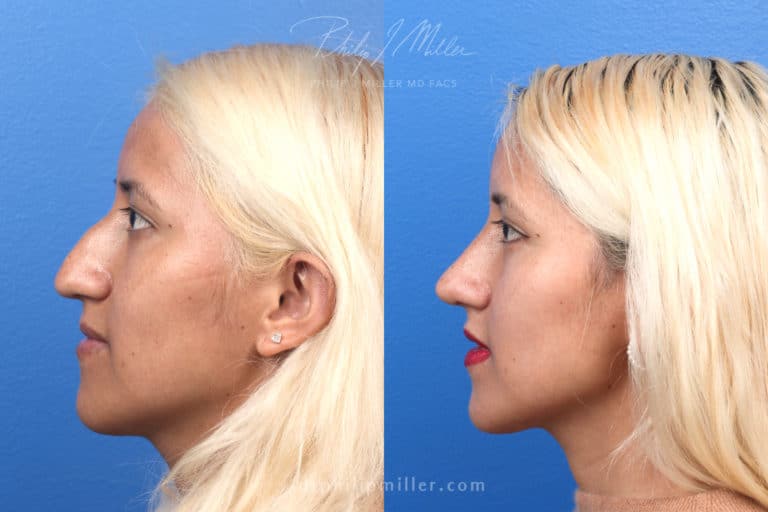
How to clean my nose after rhinoplasty?
Recovery is more than just taking it easy for a few weeks and just resting at home. You will also need to take care of your nose while it heals by keeping it clean and clear. This will not only aid in proper healing, but will help you feel more comfortable too.
Cleaning should only be done after any packing has been removed from your nose. You may use a Q-tip and hydrogen peroxide to gently clean and disinfect your nose. To remove dried blood and mucus out of the nasal passages, you may use a saline spray to irrigate your nose, clear drainage, and keep it moist. The saline may also help reduce swelling in the area.
When can I wash my face after rhinoplasty?
Washing the face is another step that will help you feel better as you go through your rhinoplasty recovery. Once the tape, splint, or cast is removed, you can wash your face with water and a gentle facial cleanser. Avoid rubbing your face around the nose – instead, pat dry carefully so you don’t disturb the treatment area.
What can I eat after rhinoplasty?
Rhinoplasty surgery shouldn’t restrict your diet significantly, but there are general guidelines after your procedure:
- Eat soft, easy-to-digest foods like oatmeal, mashed potatoes, yogurt, scrambled eggs, and soup (not too hot) for the first few days.
- Avoid hard or crunchy food items like apples and carrots that can increase facial movement, or foods like burgers and large sandwiches that require you to open your mouth wide. The idea is to put as little strain on the nasal structure and surrounding tissue as possible.
- Avoid salty foods which will increase fluid retention in your body and can lead to more swelling.
- Eat healthy foods like fruits, vegetables, and proteins that will promote wound healing (e.g., berries, leafy greens, beans, nuts and seeds, and poultry).
- Drink plenty of fluids to keep yourself sufficiently hydrated.
How to massage nose after rhinoplasty
Dr. Miller may prescribe gentle nasal massage on the bridge, middle, or tip of the nose to help soften scar tissue, reduce swelling, and promote healing. Always check with your surgeon before performing any physical therapy or massage after your surgery. In general, the pressure of the massage should be firm enough to smooth the swelling caused by fluids but not so hard that it causes pain, bruising, or deformity to your delicate tissues.
As a general rule, avoid placing any pressure on one part of the nose that causes significant movement in other areas of the nose. You must use your fingers to support the nose to prevent excessive movement during the massage. We will instruct you on how to massage your nose if this is a step we recommend for you during recovery.
How should I sleep after rhinoplasty?
Your nose will be delicate and malleable after surgery, so it is crucial that you do not sleep on your stomach or side for several weeks. These positions can put unnecessary pressure on your nose, cause discomfort, and also compromise your results. Sleeping on your back, elevated with a few pillows, is the best sleeping position for your first week or two of recovery. This position will minimize fluid buildup and congestion. It is also best to sleep alone to avoid any accidental elbow to the face that may impact your rhinoplasty results.
Experiencing slight disturbances in your sleep patterns is normal. Dr. Miller may prescribe a light sleeping aid or pain medication to help you through the first few nights.
Why Dr. Miller is a Top Choice for Rhinoplasty in New York
The best way to ensure a positive recovery after a nose job is to follow all of Dr. Miller’s instructions, go into your procedure with realistic expectations and come to all your follow-up appointments.
To schedule a consultation with Dr. Miller, contact our New York City plastic surgery clinic today.
